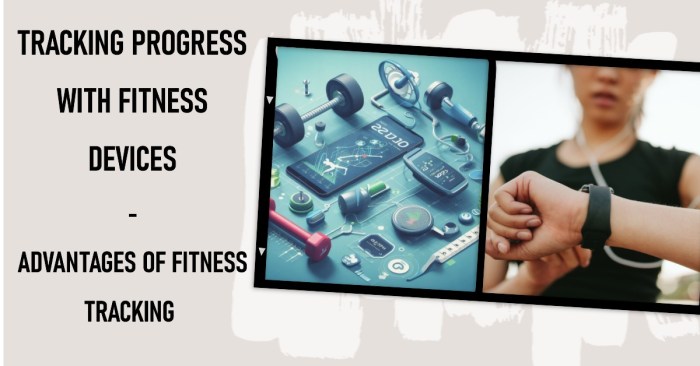Monitoring Progress

Tracking progress in your fitness journey – Tracking progress in fitness journeys is crucial for several reasons. It helps individuals stay motivated, identify areas for improvement, and adjust their strategies accordingly. By monitoring progress, fitness enthusiasts can objectively assess their efforts and make informed decisions to optimize their training.
Various effective methods can be used to track progress, each with its own advantages and disadvantages. Fitness trackers, such as smartwatches and fitness bands, provide real-time data on metrics like steps taken, calories burned, and heart rate. Journals, on the other hand, offer a more personalized approach, allowing individuals to record their workouts, nutrition, and overall well-being. Fitness apps combine the benefits of both methods, providing comprehensive tracking features, personalized insights, and community support.
Fitness Trackers
- Advantages: Provide real-time data, track multiple metrics, and offer insights into fitness patterns.
- Disadvantages: Can be expensive, may not be suitable for all activities, and require regular charging.
Journals
- Advantages: Personalized and flexible, allow for detailed tracking of workouts, nutrition, and well-being.
- Disadvantages: Requires manual data entry, can be time-consuming, and may lack objective metrics.
Fitness Apps
- Advantages: Combine features of fitness trackers and journals, provide personalized insights, and offer community support.
- Disadvantages: May require a subscription, can be overwhelming for beginners, and rely on accurate data input.
Metrics for Measuring Success
Measuring fitness progress is crucial for staying motivated and making adjustments to your fitness routine. Here are key metrics to consider:
Weight: Weight is a basic indicator of overall body mass, but it doesn’t distinguish between muscle and fat. However, tracking weight changes over time can provide insights into overall progress.
Body Fat Percentage: Body fat percentage measures the proportion of fat mass to total body weight. It’s a more accurate indicator of fitness than weight alone, as it reflects body composition.
Strength: Strength measures the ability of muscles to exert force against resistance. It can be measured through exercises like squats, bench press, or deadlifts.
Endurance: Endurance measures the ability to sustain physical activity over an extended period. It can be measured through activities like running, cycling, or swimming.
Setting Realistic Goals
When setting fitness goals based on these metrics, it’s important to be realistic and achievable. Here are some examples:
- Weight: Aim to lose or gain weight gradually, at a rate of 1-2 pounds per week.
- Body Fat Percentage: Aim to reduce body fat percentage by 1-2% per month.
- Strength: Aim to increase weight lifted or repetitions performed by 5-10% per month.
- Endurance: Aim to increase distance or duration of exercise by 10-15% per month.
Data Analysis and Interpretation
![]()
Analyzing progress data is crucial for making informed decisions and optimizing your fitness journey. It provides valuable insights into your performance, strengths, and areas for improvement.
Trend Analysis
Trend analysis involves examining patterns in your data over time. By identifying trends, you can assess your progress, predict future outcomes, and make necessary adjustments to your training plan.
Goal Tracking
Comparing your progress to pre-defined goals helps you stay motivated and track your achievements. It allows you to set realistic milestones, measure your success, and make timely course corrections.
Benchmark Comparison
Comparing your performance to industry benchmarks or other individuals can provide context to your progress. It helps you identify areas where you excel and where you need to improve.
Tips for Accurate Data Interpretation
- Use reliable data sources and tracking methods.
- Identify patterns and trends, rather than focusing on isolated data points.
- Consider external factors that may influence your progress, such as sleep, nutrition, or stress.
- Seek professional guidance from a qualified fitness expert for personalized analysis and recommendations.
Visualizing Progress
Visualizing progress is a powerful tool that can help you stay motivated and accountable on your fitness journey. By creating charts, graphs, and dashboards, you can track your progress over time and see how your efforts are paying off.
There are many different ways to visualize your progress. Some popular methods include:
- Line charts: Line charts show how a value changes over time. They are a good way to track your progress over time, especially if you are making gradual progress.
- Bar charts: Bar charts show how different values compare to each other. They are a good way to compare your progress to others or to see how you are doing in different areas.
- Pie charts: Pie charts show how different parts of a whole compare to each other. They are a good way to see how you are spending your time or how your progress is distributed.
- Dashboards: Dashboards are a collection of charts and graphs that provide a quick overview of your progress. They are a good way to see how you are doing in all areas of your fitness journey.
Choosing the Right Visualization
The best way to visualize your progress will depend on your individual needs and preferences. If you are not sure which type of visualization is right for you, try experimenting with different types until you find one that works well for you.
Tips for Creating Effective Visualizations
- Use clear and concise labels. Make sure your charts and graphs are easy to understand, even for people who are not familiar with your data.
- Use colors and fonts that are easy to read. Avoid using colors that are too bright or fonts that are too small.
- Keep your visualizations simple. Don’t try to cram too much information into one chart or graph. Instead, focus on showing the most important data.
- Update your visualizations regularly. As your progress changes, so should your visualizations. Make sure to update your charts and graphs regularly so that they always reflect your current progress.
Challenges and Obstacles: Tracking Progress In Your Fitness Journey
Progress tracking can face numerous challenges and obstacles that can hinder progress. Identifying these challenges and implementing strategies to overcome them is crucial for effective tracking. Some common challenges include:
Staying Motivated
Maintaining motivation throughout the tracking journey can be challenging. Strategies for staying motivated include setting achievable goals, celebrating milestones, and seeking support from friends or family.
Setting Realistic Goals
Setting unrealistic goals can lead to discouragement and derail progress. Setting specific, measurable, achievable, relevant, and time-bound (SMART) goals helps ensure progress is tracked effectively.
Adapting Tracking Methods
Progress tracking methods should be tailored to individual needs and preferences. Finding a method that aligns with personal style and preferences enhances the likelihood of consistent tracking.
Seeking Support, Tracking progress in your fitness journey
Progress tracking can be challenging, especially during setbacks. Seeking support from friends, family, or a fitness professional can provide encouragement and accountability.

